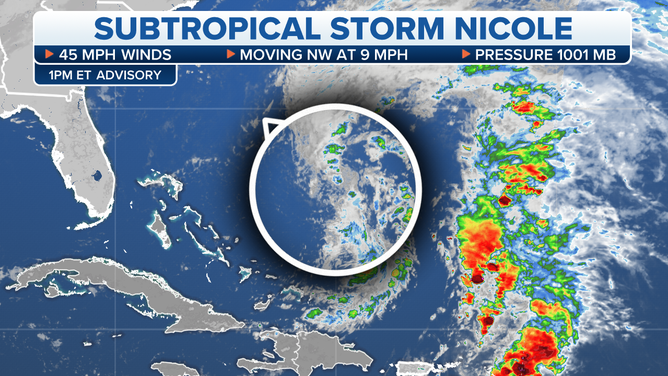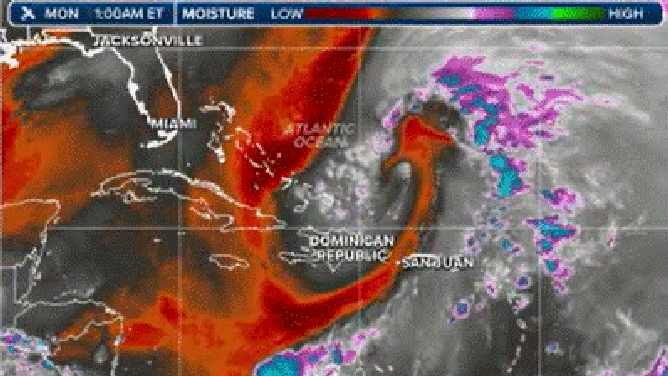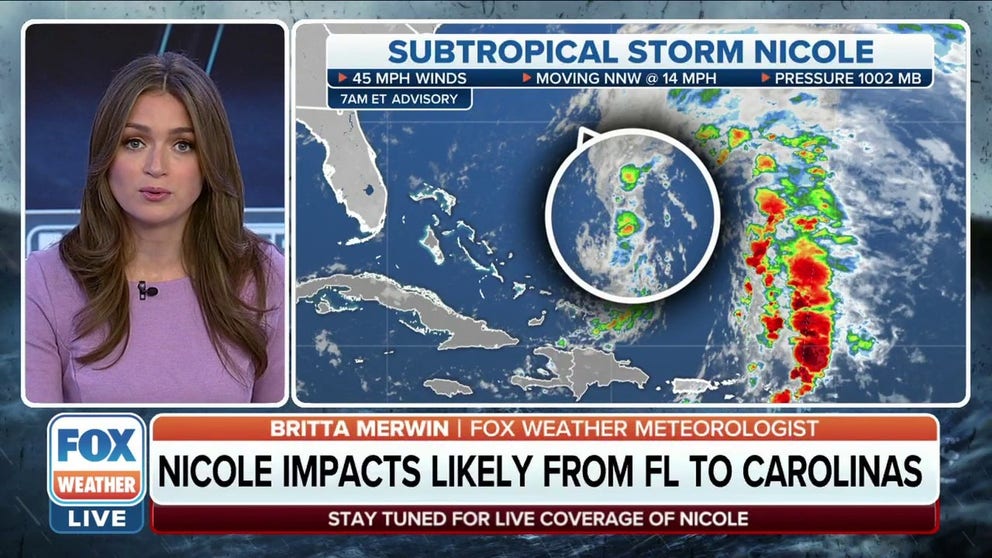Can subtropical storms become hurricanes?
Subtropical Storm Nicole has to go through a few changes before becoming classified as a traditional tropical storm or a hurricane. Here's what has to happen first:
Subtropical Storm Nicole could become hurricane as it approaches Florida this week
Subtropical Storm Nicole formed early Monday morning northeast of the Bahamas in the southwestern Atlantic Ocean and is expected to strengthen as it brings prolonged rain, wind and storm surge impacts to Florida and the southeastern U.S. this week.
Ian-weary Floridians and South Carolinians are still cleaning up after the Category 4 hurricane tore through in late September. Now they are nervously eyeing Subtropical Storm Nicole. But can a subtropical storm still become a hurricane? Yes, it can.
WHAT'S THE DIFFERENCE BETWEEN A TROPICAL STORM AND A SUBTROPICAL STORM?
Nicole has to go through a few changes before becoming classified as a traditional tropical storm or a hurricane. The most obvious, looking at satellite imagery, is the shape.
'More like a comma instead of a doughnut'
"(Subtropical Storm Nicole) does look very different than what you typically would see with a tropical system because of that infusion of dry air," explained FOX Weather Meteorologist Britta Merwin. "How I like to describe it to folks that aren’t too familiar with subtropical systems is that it looks more like a comma instead of a doughnut, which is what you would expect with a purely tropical system."

The center of Subtropical Storm Nicole is not symmetrical.
(FOX Weather)
Tropical storms and hurricanes typically have a tight ring of thunderstorms surrounding the eye that makes the system look a bit like a doughnut.
Subtropical storms are usually bigger
Subtropical storms, like their tropical counterparts, also have well-defined centers and closed circulations. However, their area of maximum winds and organized thunderstorms in that circulation are farther away from the center, which gives the storm less symmetry – again, looking more like a comma. The band of heavy thunderstorm activity is generally at least 100 miles from the center, according to the National Weather Service.
"One of the big ticket items is that the wind field tends to be very large," Merwin said. "Think about when you're thinking about a nor'easter on the northeast coast. These are massive storms where the winds stretch very far from the center of the storm. Subtropical storms are kind of similar to that – their wind fields are large, and they really stretch over a far distance."

A subtropical system's strongest winds are away from the center and is asymmetrical with cold, dry air intruding into the northwest.
(NOAA/NASA/NRL)
To compare, Hurricane Ian’s strongest winds only stretched 50 miles from its center, according to the FOX Forecast Center.
Only the small eye is relatively cloud-free in a hurricane, whereas there are larger areas of clearing around the circulation center in a subtropical storm.

This is Tuesday evening's satellite loop of Hurricane Ian closing in on Florida
(NOAA)
A subtropical storm has characteristics of both tropical and extratropical, or non-tropical, cyclones. An extratropical storm is the type we are used to seeing with fronts moving across the U.S. every day.
Subtropical, tropical and extratropical storms or cyclones have an area of low pressure at their center. Subtropical and tropical storms don't have cold or warm fronts though, and subtropical storms usually produce less rain than tropical storms.
The subtropical storm can generate winds up to and over hurricane strength – defined as winds of at least 74 mph – but it's still not classified as a hurricane yet. We need to look into what drives a storm, its powerhouse, to define a hurricane.

Subtropical storms have tropical and non-tropical characteristics.
(FOX Weather)
The storm's fuel defines subtropical versus tropical
Unlike a tropical system, a subtropical storm derives most of its energy from the clash of warm and cold air and has a core of cold air at the upper levels of the atmosphere. This happens because warm air is less dense than cold air. As cold air pushes into the warm air, the warm air is forced up and out of the way. This lift often creates clouds and precipitation.
That is what is happening with Nicole early in the week. Water vapor imagery of Subtropical Storm Nicole from Monday morning shows the cooler, dryer air, indicated in red, wrapping into its center.

Water vapor images of Subtropical Storm Nicole shows the intrusion of cold, dry air (red) into the center of the storm.
(FOX Weather)
The transition to a hurricane requires the subtropical storm to develop a warm-core. That means its primary energy source comes from the latent heat of condensation. Warm, moist air over the warm ocean rises, water vapor condenses into droplets and heat is released. As the newly warmed air continues to rise (think hot air balloon) it pulls in more humid air up from the surface of the water.
Hurricane categories explained: How dangerous is a storm?
Amy Freeze and Jason Frazer explain the anatomy, categories, and dangers of hurricanes—as well as how to prepare when one is heading your way.
Forecasters are watching to see if Nicole changes from being subtropical to more of a tropical-fueled storm as it approaches Florida.
Both types of storms are dangerous
No matter whether a storm is tropical or subtropical, they both can be powerful and still require preparations, especially on the coast.
With a large storm such as Nicole, hurricane forecasters stress not to focus on Nicole's exact makeup, track or forecast cone. Hazards, including damaging winds, dangerous seas, storm surge and deadly riptides, will extend far outside the forecast cone.

